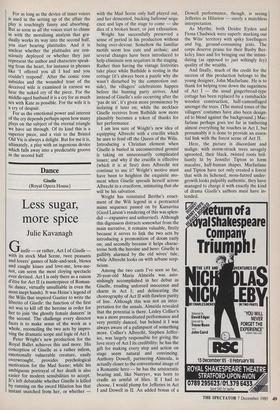Dance
Giselle (Royal Opera House)
Less sugar, more spice
Julie Kavanagh
iselle — or rather, Act I of Giselle with its stock Mad Scene, twee peasants and lovers' games of hide-and-seek, blown and caught kisses and love-me, love-me- not, can seem the most cloying spectacle ever devised. Act 1 is only there as a raison d'être for Act II (a masterpiece of Roman- tic dance, virtually unsulliable in even the most inept hands). It was Heine's legend of the Wilis that inspired Gautier to write the libretto of Giselle: the function of the first act was to kill off the heroine in order for her to join 'the ghostly female dancers' in the second. The challenge every director faces is to make sense of the work as a whole, reconciling the two acts by impro- ving the dramatic scope and logic of Act I.
Peter Wright's new production for the Royal Ballet achieves this and more. His conception of Giselle as a rather infirm, emotionally vulnerable creature, easily overwrought, provides psychological motivation for the Mad Scene; while his ambiguous portrayal of her death is also easier for modern sensibilities to accept. It's left debatable whether Giselle is killed by running on the sword Hilarion has that instant snatched from her, or whether —
G
with the Mad Scene only half played out, and her demented, bucking ballonne sequ- ence and laps of the stage to come — she dies of a broken heart, or just exhaustion.
Wright has successfully preserved a sense of period in his production without being over-devout. Somehow the familiar motifs seem less cute and archaic; and several changes have been introduced to help eliminate non sequiturs in the staging. Rather than having the vintage festivities take place while Bathilde is resting in the cottage (it's always been a puzzle why she wasn't disturbed by the commotion out- side), the villagers' celebrations happen before the hunting party arrives. And instead of Giselle's solo occurring after the `pas de six', it's given more prominence by isolating it later on; while the necklace Giselle receives from Bathilde now more plausibly becomes a token of thanks for her performance.
I am less sure of Wright's new idea of equipping Albrecht with a crucifix which he uses to fend off the Queen of the Wilis. Introducing a Christian element when Giselle is buried in unconsecrated ground is taking on unnecessarily complicated issues; and why if the crucifix is effective (which it is at first) does Albrecht not continue to use it? Wright's motive must have been to heighten the exquisite mo- ment when Giselle spreads herself across Albrecht in a cruciform, intimating that she will be his salvation.
Wright has reinstated Berthe's enact- ment of the Wili legend in a protracted mime sequence passed on by Karsavina (Gerd Larson's rendering of this was splen- did — expansive and unhurried). Although this digression distracts somewhat from the main narrative, it remains valuable, firstly because it serves to link the two acts by introducing a premonition of doom early on; and secondly because it helps charac- terise both the heroine and hero: Giselle is gullibly alarmed by the old wives' tale, while Albrecht looks on with urbane scep- ticism.
Among the two casts I've seen so far, 20-year-old Maria Almeida was asto- nishingly accomplished in her debut as Giselle, exuding unforced innocence and charm in Act I; and delineating the choreography of Act II with flawless purity of line. Although this was not an inter- pretation for the annals, Almeida revealed that the potential is there. Lesley Collier's was a more premeditated performance and very prettily danced, but behind it I was always aware of a palimpsest of something more. Collier's Albrecht, Stephen Jeffer- ies, was largely responsible for giving the love story of Act I its credibility: he has the gift for making every step and action on stage seem natural and convincing. Anthony Dowell, partnering Almeida, is actually closer to the conventional image of a Romantic hero — he has the aristocratic bearing and, like Nureyev, was born to cradle an armful of lilies. If I had to choose, I would plump for Jefferies in Act I and Dowell in II. An added bonus of a Dowell performance, though, is seeing Jefferies as Hilarion — surely a matchless interpretation.
As Myrthe, both Deidre Eyden and Fiona Chadwick were superb: marking out the Wilis' territory with spiky forefingers and big, ground-consuming jetes. The corps deserve praise for their Busby Ber- keley lines and for bringing out the intimi- dating (as opposed to just wittingly fey) quality of the wraiths.
And finally, much of the credit for the success of this production belongs to the young designer, John Macfarlane. He is to thank for helping tone down the sugariness of Act I — the usual gingerbread-type cottage has been replaced by a ramshackle wooden construction, half-camouflaged amongst the trees. (The muted tones of the villagers' costumes have also been design- ed to blend against the background.) Mac- farlane perhaps goes too far in timbering almost everything he touches in Act I, but presumably it is done to provide an essen- tial link with the forest scene of Act II.
Here, the picture is discordant and malign: with storm-struck trees savagely uprooted, their black, twisted roots bril- liantly lit by Jennifer Tipton to form macabre, half-human shapes. Macfarlane and Tipton have not only created a forest that with its lichened, moss-furred under- growth looks palpably authentic, they have managed to charge it with exactly the kind of drama Giselle's authors must have in- tended.


































































 Previous page
Previous page